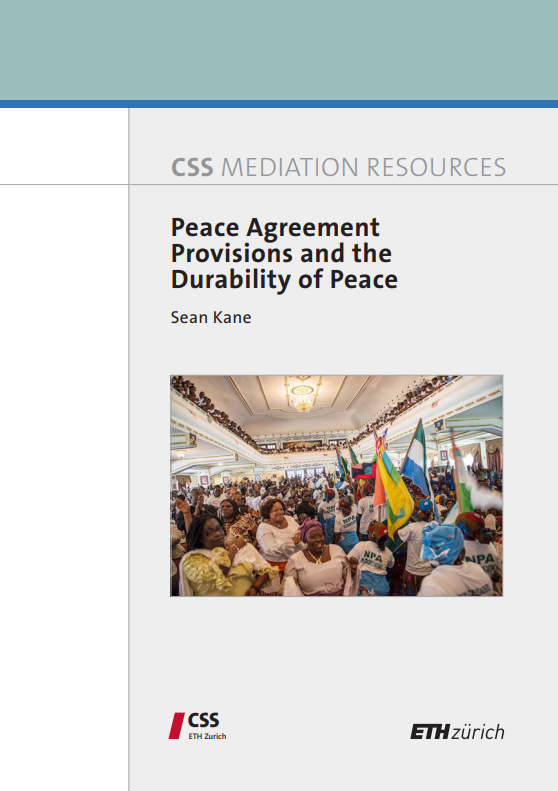The number and range of provisions in a peace agreement and their implementation level strongly predict peace’s durability. Specifically, Comprehensive Peace Agreements (CPAs), which include all negotiated terms, are more likely to result in lasting peace. It emphasizes the importance of societal support, socio-political reforms, and high implementation rates of agreement provisions in achieving enduring peace.
Also, it underlines the positive effect women’s participation in peace negotiations has on the quality and durability of peace agreements. This beneficial outcome arises from increased political reform provisions and higher implementation rates when women sign the agreements. Various women’s groups have cooperated to significantly enhance agreements’ content and implementation rates, improving the durability and quality of peace agreements overall.
Overview
Research Findings on Designing Credible Guarantees in Peace Agreements
Explores the theoretical and empirical aspects of peace agreement provisions to ensure credibility and longevity. Specifically, it offers insights into various guarantees and provisions within peace agreements. Importantly, these can address the challenges of credible commitment, thereby enhancing the chances of successful conflict resolution and peacebuilding efforts.
- External Guarantees: Barbara Walter’s theory emphasizes the importance of external guarantees in civil war settlements to overcome the credible commitment problem. External enforcers can help ensure the future enforcement of agreements and prevent renewed attacks after disarmament.
- Power-sharing: Power-sharing arrangements are proposed to create checks and balances within peace agreements, enhancing their credibility and sustainability.
- Ceasefires and Signaling Intentions: Ceasefire signaling mechanisms are crucial for reducing uncertainty and increasing the costs of cheating on ceasefire agreements.
- Comprehensive Peace Agreements: Cover multiple policy sectors and are seen as insurance against the non-implementation of any single issue. Such agreements are believed to contribute to longer-lasting peace.
Research Findings on Frequently Used Provisions in Peace Agreements
Examines the relationship between commonly included provisions in peace agreements and the duration of peace. Specifically, it emphasizes these provisions’ importance and impact on the longevity and effectiveness of peacebuilding efforts. Therefore, by strategically addressing these key areas, mediators and conflict parties can promote sustainable peace and reconciliation in post-conflict societies.
- Post-Conflict Elections: Post-conflict elections have become increasingly common in peace agreements and are crucial in transitioning from conflict to everyday politics. However, early elections post-agreement may pose challenges and potentially incite further violence if results are contested.
- Justice/Dealing with the Past: Addressing justice issues and dealing with the past within peace agreements is essential for reconciliation and long-term peacebuilding efforts.
- Civil Society Inclusion: Involving civil society in peace processes and decision-making is vital for enhancing the legitimacy and sustainability of peace agreements.
- Gender: The participation of women in peace agreements has been linked to more durable peace outcomes, highlighting the importance of gender inclusivity in mediation processes.
- Humanitarian Action: Including provisions related to humanitarian action in peace agreements is crucial for addressing humanitarian needs and promoting stability in post-conflict settings.
Research Findings on the Implementation of Peace Agreements
Highlights the crucial aspect of implementing peace agreements and their impact on the sustainability of peace. It underscores the importance of negotiating effective peace agreement provisions and ensuring their successful execution to bolster sustainable peacebuilding efforts. By recognizing the implementation patterns and strategically focusing on essential areas for successful execution, mediators and stakeholders can strive to build enduring peace in conflict-affected regions.
- Implementation Rate and Timing: Research shows that the provisions of peace agreements vary in implementation. Ceasefires, international verifications, electoral reforms, prisoner releases, and amnesties have higher implementation rates. Media reform, territorial and economic power-sharing, and human rights are less likely to be implemented.
- Implementation and Peace Duration: The aggregate total implementation of peace agreement provisions has been found to promote durable peace. Successful implementation of different types of provisions is crucial for maintaining long-lasting peace.
Conclusions on Peace Duration
Offers valuable insights into the various factors affecting peace agreements’ longevity and sustainability. For instance, mediators can contribute to sustainable peace processes and conflict resolution by understanding these factors and strategically applying negotiation and implementation approaches.
- Types of Provisions Showing Evidence of Impact on Peace Duration: Factors like external security guarantees, power-sharing provisions, third-party monitoring, force separation, and prompt reform implementation before post-conflict elections can significantly impact peace duration. Including diverse provisions and implementation mechanisms can enhance lasting peace.
- Types of Provisions Where Evidence of Impact on Peace Duration was not Found: Political power-sharing only sometimes significantly impacts peace duration, despite its everyday use in peace talks. This inconsistent correlation has sparked further investigation into the reasons behind it.
- Prudent Application: Mediators and parties must design and implement peace agreements with enough political backing and resources. A balance between detailed plans and adaptability is vital for successful peacebuilding.
Furthermore. Moreover. Nonetheless. However.




